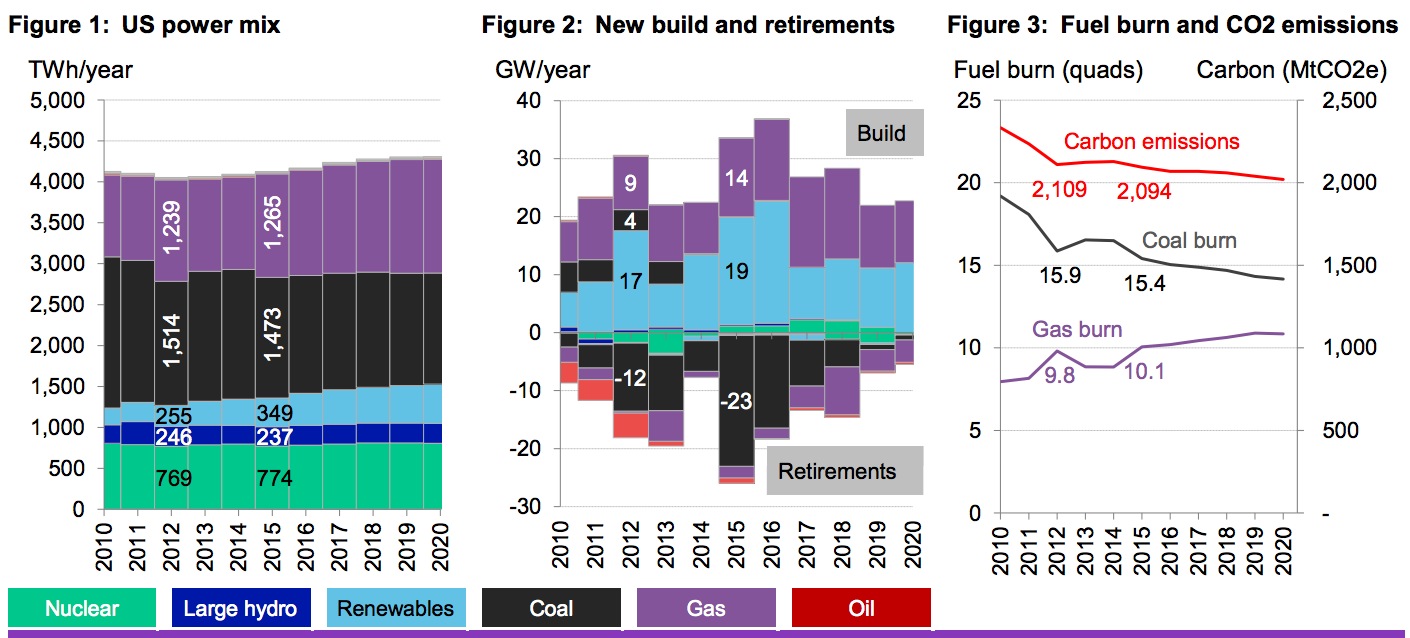BLOOMBERG NEW ENERGY FINANCE
In 2015, the US could set new national records: for annual renewable build; for coal retirements; and for gas burn from the power sector. Meanwhile, electricity-related emissions could fall to their lowest levels since 1994. This Research Note examines our short-term forecasts for US power.
- Renewable build will total 18.3GW in 2015 – 9.1GW from solar (an all-time high); 8.9GW from wind (third-most ever). Both technologies are in the midst of a temporary build rush, as developers race to capture important federal tax incentives that are set to step down or expire by 2017. California will account for over half of the solar build in 2015; ERCOT will absorb over one third of the new wind.
- The Mercury and Air Toxics Standard (MATS) take effect on 16 April 2015, hastening a wave of coal retirements among generators whose economics are otherwise challenged by the effects of old age and cheap gas. In all, expect 23GW to stop burning coal this year, with another 30GW falling offline before decade-end. PJM and the Southeast will be hardest hit.
- Natural gas-fired generators are poised to back-fill lost generation from retiring coal; and even more importantly, plummeting gas prices have enabled efficient, combined-cycle gas turbines to undercut marginal costs of coal in many parts of the country. Coal-to-gas switch calculus is complex, but we believe these two factors (lost coal capacity and a relative improvement in gas-fired economics) will lead to the most gas burn from the power sector ever – more even than witnessed in 2012 (‘the year of no winter’, when Henry Hub sank below $3/MMBtu).
- Only 8% of the nation’s power-sector carbon emissions are actually ‘covered’ by cap-and-trade; meaning only 8% carry a price tag. But the industry should take notice of emissions levels in light of the Clean Power Plan, which is (mis)-understood to call for a ‘30% carbon cut from 2005 levels by 2030’. Our estimate puts 2015 emissions at 2,094MtCO2 – 16% below 2005 levels, and roughly 350Mt away from our 2030 ‘goal’. On an emissions rate basis (t/MWh), 2015 will be the cleanest year in over 60 years for which we have historical data.
- This Research Note is more sensationalist than we typically write. While it is true that US power will break several records in 2015, it is important to keep these changes in a broader context. Figure 1 tells a relatively sobering story: that at a high level, even when multiple records are broken, the generation mix from one year to the next looks roughly similar. There is plenty of inertia in a +1,000GW, +4,000TWh/year system such as the US power grid. Change comes slowly, even in the most transformative times
Download full version (PDF): Medium-Term Outlook for U.S. Power – 2015=Deepest De-Carbonization Ever
About Bloomberg New Energy Finance
about.bnef.com
Bloomberg New Energy Finance provides unique analysis, tools and data for decision makers driving change in the energy system. With unrivalled depth and breadth, we help clients stay on top of developments across the energy spectrum from our comprehensive web-based platform.
Tags: Bloomberg, Bloomberg New Energy Finance, Cap-And-Trade, Carbon, Coal







 RSS Feed
RSS Feed
This analysis is too limited in relation to the size of the problems we face. What is required is described in an 2014 article in the journal Energy, entitled “A Roadmap for Repowering California for all purposes with Wind, Water and Sunlight” to reach 100% renewable by 2050. It would not be easy or inexpensive, but it appears to be doable. A similar study has been done for NY State and other states – doing all 50 is the goal of the group at Stanford University. If you are interest in the deails, contact me.